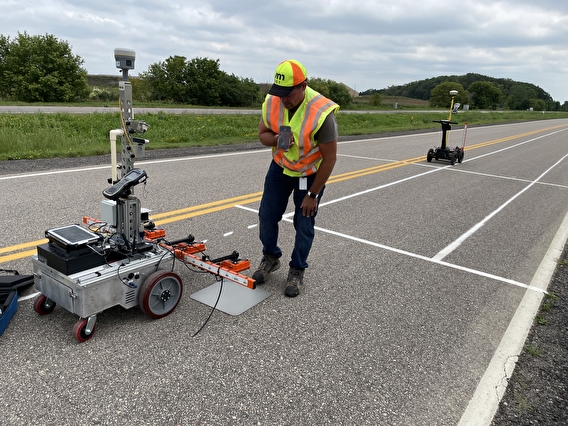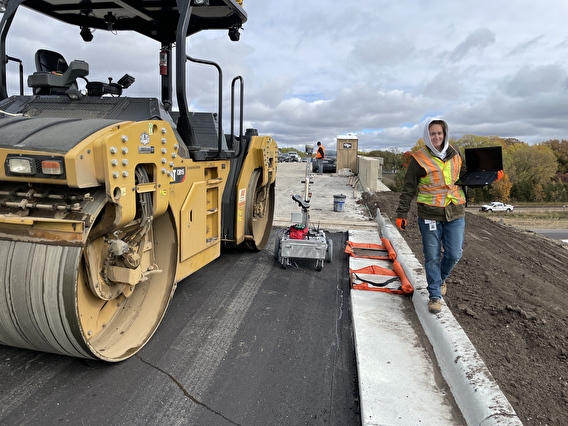
Autonomous technology aimed at making Minnesota’s roads better and safer is the focus of two new projects. The first uses robots to conduct pavement density testing for stronger, longer-lasting roads. A second project is developing self-driving trucks equipped with mounted attenuators to protect highway workers from danger in short-term work zones. The two projects were the subject of a CTS webinar held on May 8.
In Minnesota and throughout the US, many asphalt roads are nearing the end of their service lives. Replacing these roads is a major public investment, so transportation agencies must ensure they’re being built to the correct standards. One key standard is asphalt density—the most important predictor of pavement performance.
“Without acceptable density, roads are susceptible to rutting, cracking, and moisture damage,” said Nikolaos Papanikolopoulos, a professor with the U of M’s Department of Computer Science and Engineering (CS&E). “Even a small increase in density can lead to a significant increase in service life.”
As a result, he said, it is essential to apply quality assurance and control measures during the construction process to proactively identify problems and address them at this stage, rather than after the roadway is built. Traditionally, coring—a destructive testing method—has been used.
One promising, non-destructive way to monitor asphalt density during construction is ground-penetrating radar (GPR). However, this method typically requires extensive manual labor to traverse large areas, exposing the operator to traffic hazards and limiting its scalability. To address this challenge, U of M researchers turned to robotics.
“We envisioned a low-cost, highly transportable, open-architecture autonomous robot carrying a GPR system,” Papanikolopoulos said. “The robot could eliminate the need for human labor and make the technology more scalable. It could also make density measurements more consistent.”

For this project, researchers created two transportable, battery-operated robot platforms and tested them on both existing and newly constructed pavement. The platforms were purposely assembled from widely available, commercial, off-the-shelf components to minimize overall cost.
The robots’ components included a mast with a GPS receiver, several cameras and sensors, motors, batteries, antennas, a tablet computer, and the GPR system. The robots were designed to prevent tipping over, minimize vibration and skidding, carry up to 100 pounds of equipment, run for up to four hours, and be easily disassembled and reassembled.
To use the robot, operators input job parameters (including road design documentation) to generate a plan for profiling the desired pavement area. Researchers tested the first robot’s ability to autonomously traverse a specified section of pavement at the Minnesota Department of Transportation’s MnROAD test facility.
They found that the robot was relatively accurate—it was able to stay within six inches laterally of the path. Researchers expect additional tuning could further improve performance.
In the project's final phase, researchers created the second robot with a higher level of autonomous operation so it could alter its behavior based on sensory information. These enhancements included sensors and algorithms to that could prevent collisions with both moving and fixed objects and adjust the robot’s path when the built road deviates from design plans. During the construction process, the actual asphalt joint-line locations can deviate from the plans. “We want the robot to be able to adjust its path based on these ‘real-world’ joint lines,” Papanikolopoulos explained.
The research was co-funded by CTS; Ted Morris, CS&E research engineer, served as co-investigator. An operator procedural field guide was drafted and delivered as part of the project.
Of course, even the best-built roads need routine maintenance such as repairing cracks, potholes, and guardrails. For short-term projects like these, MnDOT uses a special work-zone setup with crash-absorbing attenuators mounted to the back of several large maintenance trucks (the type used for plowing snow) following behind one another.
“The truck-mounted attenuators are really good at protecting our work crews, but there is still some hazard because someone is in that seat driving the truck,” said Adam Wellner, a lead project manager in MnDOT’s Office of Connected and Automated Vehicles.

During the webinar, Wellner described a MnDOT pilot project that is adding autonomous technology to the vehicles equipped with truck-mounted attenuators. The test system uses a manually driven lead truck followed by an autonomously driven vehicle. The autonomous following vehicle is the first one drivers on the road encounter, so it’s the most likely to be involved in a collision. Removing the driver from that vehicle eliminates that high-risk operator position while still protecting maintenance workers.
The pilot project began in 2019 with the autonomous technology’s installation on test vehicles. Testing began with work crews based in the Twin Cities area, and improvements were made based on operator feedback. For the 2023 construction season, MnDOT hired two temporary workers to operate the system and test it with work crews from each of MnDOT’s districts; they logged 400 hours of testing time.
For the 2024 construction season, MnDOT will once again dedicate two temporary workers to testing the system, and Wellner expects it to be the most successful round of testing so far. “While we are not ready for widespread deployment yet, we are learning the things we need to learn to get to that point,” Wellner added. “Our objective is ultimately to get people out of those vehicles so if somebody hits them, we don’t have a person sitting in that seat.”
—Megan Tsai, contributing writer

